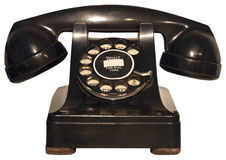
One of the problems of old age is that nothing looks the way it ought to any more. Take telephones. I have a very clear mental picture of what a telephone ought to look like. It is black, shaped like a truncated pyramid with concave sides and a cradle on the top to hold the receiver. On the front is a circular dial with a chrome-plated surround containing 10 holes. You dialled a number by putting the tip of your index finger into a hole and pulling the dial around clockwise as far as it would go, then letting it whirr back again. And so on for each digit.

My present telephone is pale yellow and shaped like a bread roll sliced in half longitudinally. The upper part acts as a receiver and also has a square keypad between the earpiece and the mouthpiece to key in numbers. There is nothing that you could accurately call a dial. And yet people still “dial” numbers. The verb has survived as a kind of fossil long after the actual thing has become extinct. Similarly the universal symbol to indicate a telephone number still looks like an old-fashioned pyramidal black telephone.
The word “dial” is itself a fossil from earlier technology. Originally it referred to a sundial. The word derives from the Latin dies meaning day, because the circle on a sundial represents the sun’s daily course through the heavens. The word came to be used of any circle with numbers on it, such as a clock face or the speedometer of a car. Or a telephone dial.
The world of computing is full of such technological fossils. Take the Shift key on your keyboard for instance. Why is it called that? It doesn't actually shift anything; it just turns lower case letters into upper case. But on a mechanical typewriter, the shift key was a lever that shifted the whole mechanism so that the upper-case letter on the type hammer came into contact with the inked ribbon rather than the lower-case one. Incidentally, the names “lower case” and “upper case” are themselves fossils dating from early printing, when type elements were stored in two connected cases, divided into sections for individual characters. There were many copies of each ordinary letter, but only a few of each capital letter were needed. The ordinary letters therefore occupied the whole of the lower case while the capitals shared the upper case with the numeric digits and punctuation marks.
If you use Windows and you create a plain text file (for example with Notepad), each line will end with two invisible characters: CR (carriage return) and LF (line feed). That is an exact copy of the way you ended a line on a typewriter. The carriage return lever pushed the paper carriage back to its original position and at the same time, the cylinder rotated slightly to give a new line.
In many icon sets, the save button looks a bit like a television set. Actually it’s meant to be a floppy disk with a label on it. There must be lots of people who still remember diskettes, but why were they called floppy disks? Because the first ones actually were flexible (though you were warned not to flex them as it would probably damage them). I have seen some pretty big ones from ancient PCs but in my time the size had standardised at five and a quarter inches. Later they were replaced by the rigid three-and-a-half inch diskettes which were hardier and had a larger capacity. Modern computers don't even have a diskette drive, but the diskette/floppy lives on as a symbol of saved work.
A final question: why do we “log in” to websites? The fossil here is made of wood. A real log, attached to a rope with knots at regular intervals, was kept on every sailing ship. Every so often it was thrown out at the bows, and the sailors timed the rate at which the ship overtook it by noting how many knots they had to pay out in a given period of time. That’s why speeds at sea are still measured in knots. The results of the test were noted down in the log book (where else!) along with the ship’s bearing, latitude and longitude, weather conditions, and anything else which was thought worth recording. So a log book came to be the name of any continuous record of events — including a computer’s record of when users’ sessions started and ended. You log in to start and log out to end.
As I will now do.
| Up | Home |